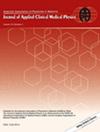Design and validation of a novel dosimetry phantom for motion management audits
Abstract
Background
We present a novel phantom design for conducting end-to-end dosimetry audits for respiratory motion management of two anatomical treatment sites. The design enables radiochromic film measurements of the dose administered to the target throughout the respiratory cycle (motion-included) and the dose delivered to the time-averaged motion of the phantom (motion-excluded) to be conducted simultaneously.
Purpose
To demonstrate the phantom's utility in a dosimetry audit and capacity to detect errors by quantifying spatial and dosimetric reproducibility.
Methods
Spatial and dosimetric reproducibility was quantified by repeat exposures using a simple lateral beam. Five exposures per measurement configuration were used. In each series of five measurements, the median film was used as the series reference to quantify the reproducibility of the remaining “test films.” Spatial reproducibility was quantified by comparing the position of isodose lines in two axes on the test films back to the series reference. Dosimetric reproducibility was quantified using gamma comparison between each test film and the series reference. Proof-of-concept of the motion-excluded measurement capability was also established by comparing all films to treatment planning system (TPS) calculated dose distributions.
Results
Spatial reproducibility was better than 1 mm on all assessed metrics across all measurements. Film-to-film local gamma passing rates at 3%/0.6 mm were above 90% for all measurements. Film-to-TPS global gamma passing rates at 3%/1 mm were >95% in the motion-excluded measurement series’, but <80% in the motion-included series, highlighting the utility of the motion-excluded measurements.
Conclusions
Measurements were highly reproducible and of sufficient accuracy/reproducibility to facilitate multiple avenues of analysis in a prospective dosimetry audit. Motion-excluded measurements were directly comparable to the TPS dose distribution. Motion-included measurements may yield more clinically-relevant information about the actual dose administered to the target. This promises greater sensitivity to motion management-related errors, detectable in the setting of a dosimetry audit for motion management.

 求助内容:
求助内容: 应助结果提醒方式:
应助结果提醒方式:


